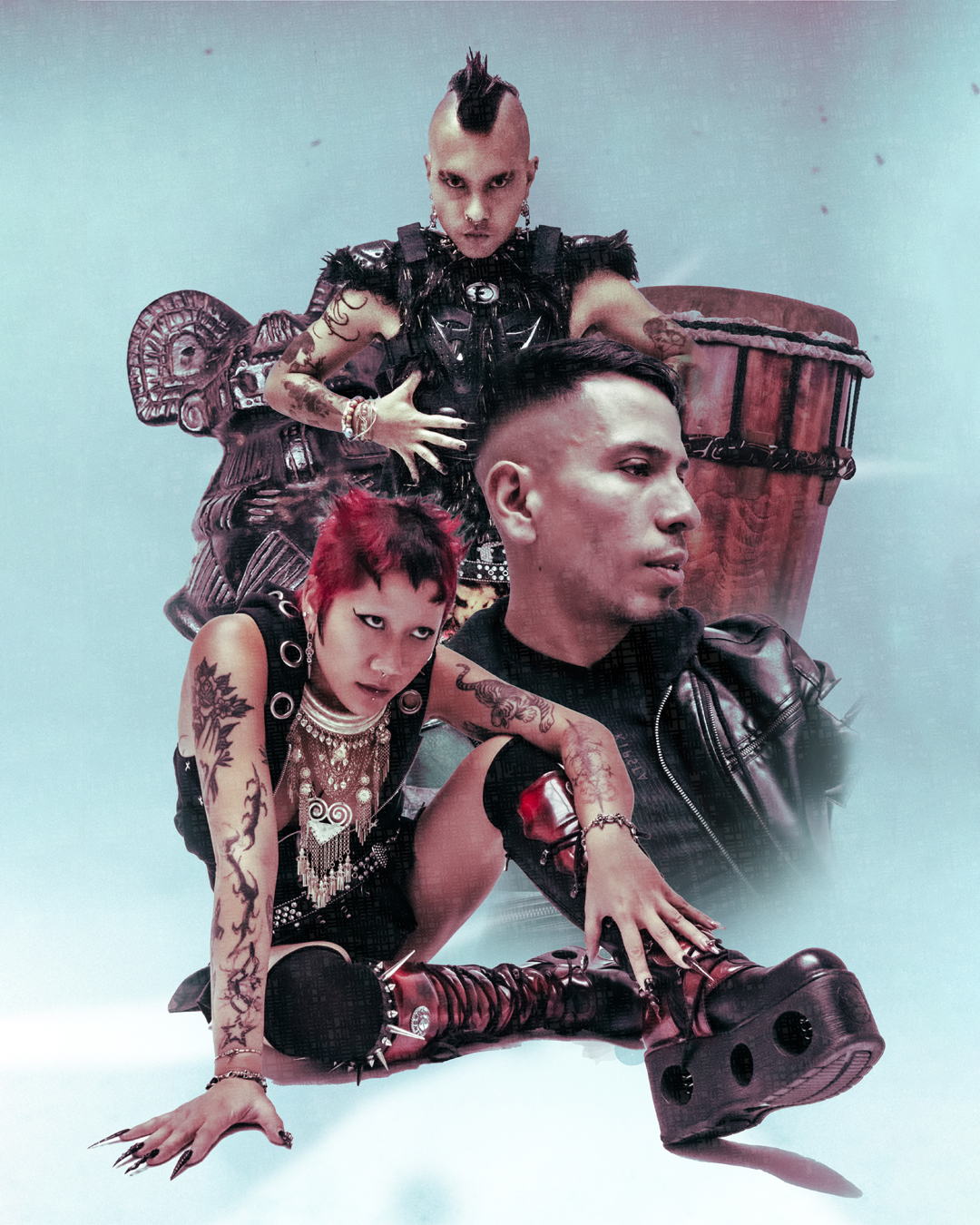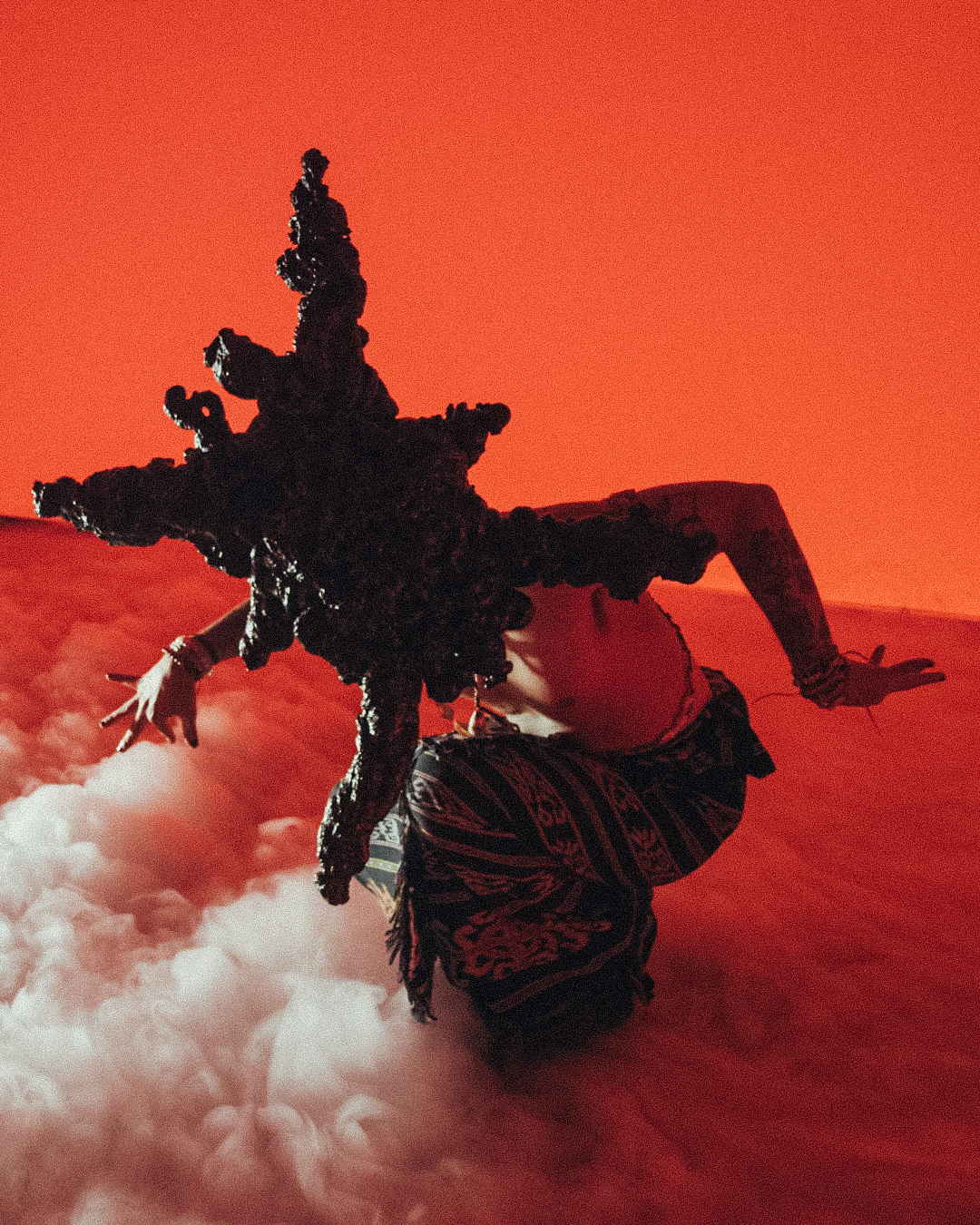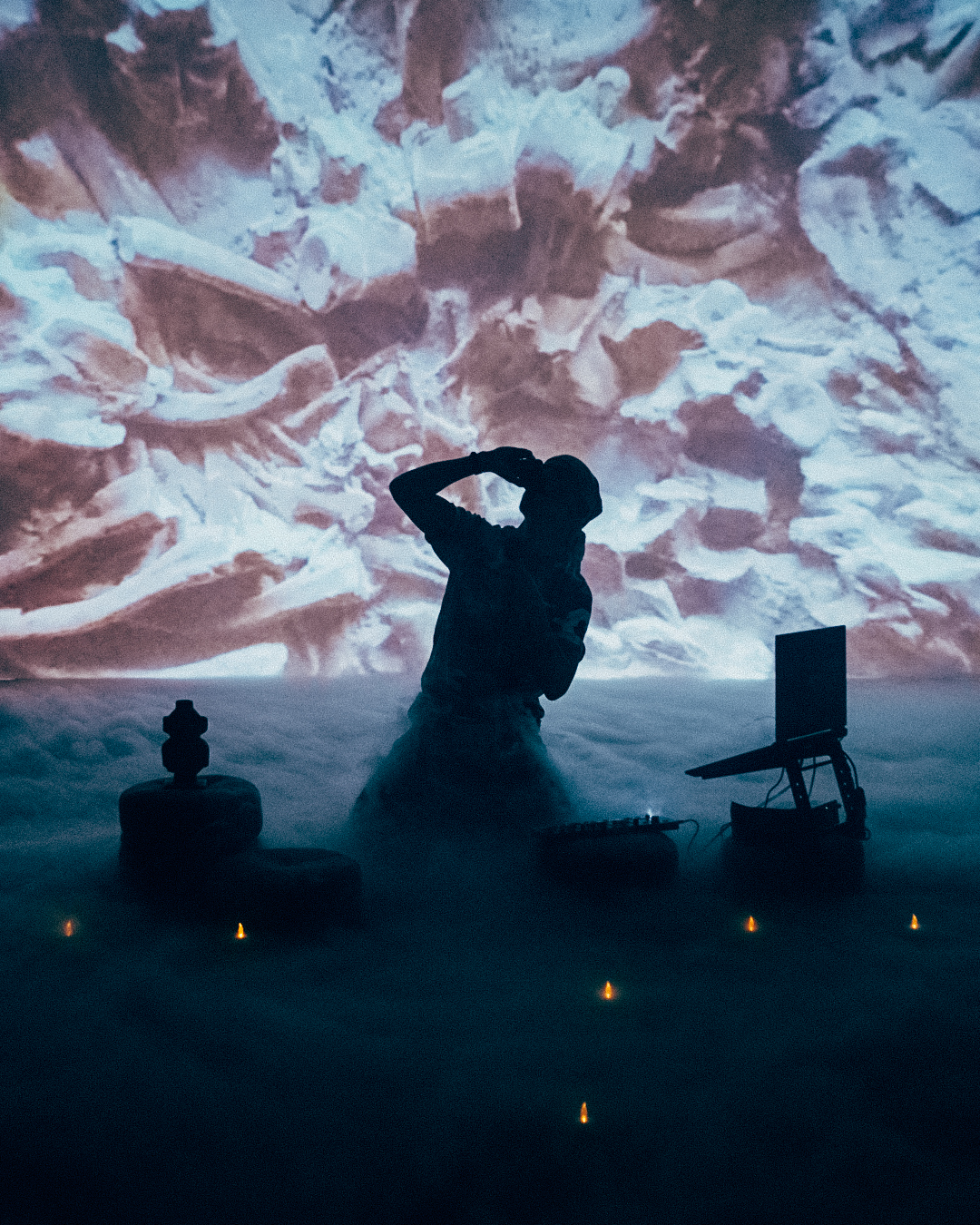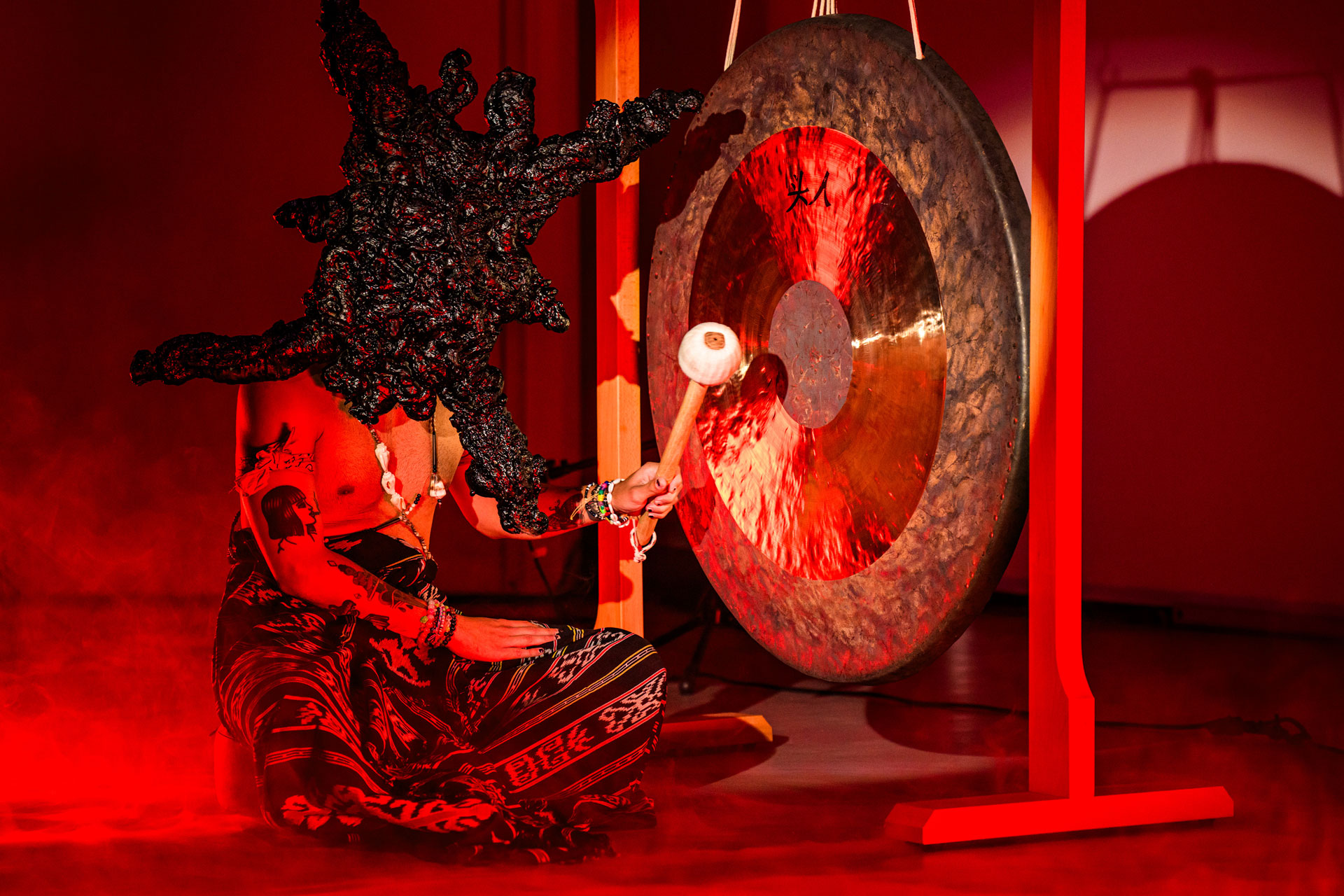“Seeing something like this by people like us in a space like that is so powerful.”

Daniel Velrome
Thức Tỉnh, meaning “Awaken,” is a mesmerising fusion of sound, movement, and visual art — a visceral heartbeat that echoes the breathless energy of a rave while delving into the profound depths of identity and heritage. Rooted in both Dutch culture and the ancestral legacies of its creators, it draws on traditions from Vietnamese-Chinese, Moluccan, and pre-Columbian cultures.
At its heart lies Jeisson Drenth’s techno-spiritual visual world, elevated by Animistic Beliefs’ masks, shadow play, and dancing, as they transcend boundaries, offering a space to embrace complexity and let go. Between rehearsals, we got to speak with the three artists about the personal and political layers in their work.
GC: Let’s start at the beginning, how did this collaboration between you all first come about? What forces or inspirations brought the three of you together?
Jeisson: For me, it was the sound. I was very into their sound and how playful and hard it is. It has so many dimensions and it’s quite colourful in different ways. That’s what drew me in.
Mar: The other way around, I really like Jeisson’s work because the way he uses technology inspires me. It’s not just visual work on a surface level; there’s a message behind it, which I really value.
Linh: I second that.

Dammes Kieft
GC: Can you tell us about the dynamics of your triangular creative process? Who starts with what?
Mar: For this show in particular, it was a bit different because we decided to work together and also explore new mediums at the same time. We weren’t just doing music or just visuals. We were having discussions, working on things separately, but also in shared spaces, showing each other our work in progress.
Linh: I think, generally, we have a lot of overlapping interests. So, when someone discovers something new, we like to share it with each other. In that way, we can also spark ideas in each other’s work.
Mar: ADHD.
Linh: ADHD and talking a lot. You know, it has its perks.
GC: My next question is about the name of the piece you’re performing on Friday — could you share how it’s pronounced?
Linh: It’s Vietnamese. It’s Thức Tỉnh.
GC: I saw that Thức Tỉnh roughly translates to “Awaken,” but I’d love to hear more from you. What deeper meaning does the title carry for this performance?
Jeisson: On a personal level, I think we’re all quite committed to finding ways to give meaning to our experiences as Dutch people of colour. We’re all learning as we go in terms of creative expression and using different creative disciplines to build our practice. Maybe that’s a bit of an ongoing awakening.

Dammes Kieft
GC: Growing up between Dutch culture and your parents’ heritage, you’re naturally familiar with navigating in-betweenness. How do you balance and express this duality in your work?
Mar: I worked with Karina Sokowati and we explored traditional Indonesian dances, which Linh and I are doing a very loose reinterpretation of. I don’t want to present it as a representation because I’m not a traditional dancer. I also had the realization during this project that I am a bi-cultural person who will never reach the ideal of a perfect Dutch individual. I’ll also never be a perfect Indonesian or Moluccan person. I want to be more gentle about it and not judge myself too harshly. I’m not perfect, and I don’t have to be.
Linh: But also, what defines perfect? You know what I mean? What is enough?
GC: Very true. I’m also a person with mixed heritage, and I feel like I always end up comparing myself to this imaginary standard of what it means to be Mexican.
Mar: I’m also trying to be more friendly towards myself, too. Accept myself for who I am.
GC: Your work stands out for being both deeply personal and political, bridging themes of queerness and colonialism that are rarely explored together. How do you navigate and merge these layers in your art?
Linh: When I think about these topics, it’s because they’re such integral parts of my life — colonialism, displacement, uprooting, and being queer. These experiences naturally come together in my embodiment as myself. So, the ideas I express, my reality, and what I experience are all shaped by these topics, my heritage, and what my parents went through. In that sense, it all blends together.
Jeisson: Being a minority, those experiences can be very similar.
GC: Are there any specific visual references in Thức Tỉnh in the masks and set design?
Jeisson: I’ve been attending exhibitions and theatre shows by Indigenous creators as part of my research into how colonial collections in Zealand are framed. For my scene, I created a world inspired by a Colombian desert — a rainforest rich in fossils and perfect for stargazing. It’s a place I dream of visiting, a space where I explore belonging and grieve displacement. I combine this with music featuring a dramatic whistle in ceramic — basically, some objects I’ve collected and connected with at home. It’s fascinating to relate to these items differently: behind glass in museums versus in my hands. It’s nice to have this tactile attraction.
GC: You’re almost breathing life back into these objects that are so sterile, put behind glass.
Jeisson: Yeah! That’s exactly the metaphor that I used in my text.

Daniel Velrome
GC: Those large headpieces — did you make them yourself, or how did they come about?
Mar: Linh and I both create masks. The large spikey black one is inspired by my nightmares and insecurities — dealing with them is part of my process of awakening. There are many masks in Indonesian culture, though these aren’t traditional ones. I’m also wearing traditional Moluccan clothing in the scene with the masks, which adds another layer of cultural reference.
GC: Sound-wise, there is a mix of traditional instruments and a lot of electronic music, which is like a guiding principle throughout your work. If you were to create a new genre name to describe your music, what would it be?
Mar: When I read the question earlier, I thought about it and came up with the word “Jiwacore.” Jiwa is an Indonesian word meaning soul, but it also refers to your essence, your core, in a spiritual sense. It’s about who you are. I think the personal is very important in music. In the end, it’s about combining all these things. For the show, we used a lot of modern electronic instruments, but I also recorded traditional sounds like Tifa drums from the Moluccan Islands and gamelan gongs, which I incorporated into both our scenes.
GC: Muziekgebouw is generally associated with more classical music. What drew you to this space for Thức Tỉnh?
Jeisson: I’ve been attending the New Year’s event by Fiber and The Rest is Noise for a while now because I love noise music and the Fiber Festival. I’ve always hoped we could perform there. Since we were familiar with the event and they knew Animistic Beliefs, it just seemed like a good fit.
Mar: They typically feature a lot of classical and traditional art and music, but I’m really proud that we got to perform in a space like this. I hope it shows others like us that there is space for people like us.

Pieter Kers
GC: For my last question, the themes of origins and identity resonate deeply with me, and I imagine, many in the audience. What do you hope people take away from experiencing Thức Tỉnh?
Linh: I think it’s always nice when you create something personal and share your story, and then you find people who relate to it — people who enjoy the same things. It’s rewarding to build new connections and spark meaningful conversations. Being surrounded by people who affirm and support you is so important — it makes the experience even better.
Jeisson: When you create something like this and share it with an audience, I hope it sparks curiosity in others. We all have juxtapositions and hidden stories in our families, so I think it’s an invitation to be curious, nurture those stories in the people around you, and have fun with it.
Don’t miss Thức Tỉnh this Friday, January 10th, at Muziekgebouw, as part of the FIBER x The Rest is Noise Festival, you can still snag up tickets here.
Images by Daniel Velrome, Pieter Kers and Dammes Kieft.
Words by Veronica Tlapanco Szabó
Notifications